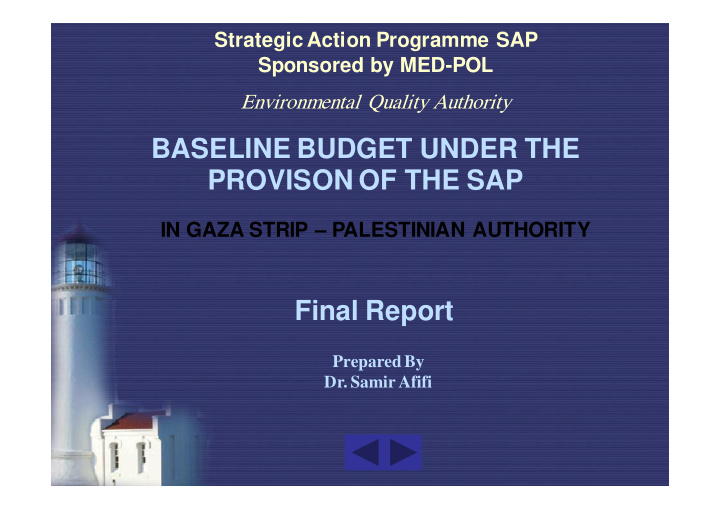



Strategic Action Programme SAP Sponsored by MED-POL Environmental Quality Authority BASELINE BUDGET UNDER THE PROVISON OF THE SAP IN GAZA STRIP – PALESTINIAN AUTHORITY Final Report Prepared By Dr. Samir Afifi
Contents • Introduction • Objectives • Classification of Industries • Distribution of Industries • Baseline budget calculation • Proposed activities • Major sources of LBS – Pollutants and waste sources – Estimated annual pollution loads • General Remarks • Capital Investment • LBS Priority Selected Monitoring program • LBS Priority Monitoring parameters
Introduction • The Strategic Action Program (SAP) • Land-Based Sources (LBS) and activities • MED-POL ( (Mediterranean Pollution)
Objectives 1. Preparation of a comprehensive inventory of the existing industry 2. Classification of the industries into sectors 3. Identification of the potential industrial sources of each pollutant targeted by the SAP and quantification/estimation of their emissions/releases 4. Calculation of the national Baseline Budget for 2003
Classification of Industries in Gaza Strip • Classification according to the hazards arising: • 1. Class A (least toxic waste) • 2. Class B (medium toxic waste) • 3. Class C (most toxic waste)
Distribution of industrial installation Distribution of industrial installation over the Gaza Strip 1000 Number of installations 800 Class A 600 Class B 400 Class C 200 0 Gaza Khan Middle North Gaza Rafah Grand Younes Total Governorate
Baseline budget calculation • Industrial, storm water runoff and domestic activities are the major sources of marine pollution in Gaza strip • Limited researches and monitoring programs were conducted by several institutions to assess the extent of coastal pollution • The assessment based on collection and assessment of existing data rather than the generation of new analytical data
Proposed activities designed to: • Identification of major Land-Based Sources (LBS) at the Gaza regional level • Identification Pollutants and waste sources considered in the estimate of annual pollution loads in the Mediterranean from LBS • Estimated annual pollution loads of the Mediterranean from LBS Identification of LBS priority Monitoring • programs • Identification of LBS priority Monitoring Parameters
Major sources of LBS at the Gaza regional level • Domestic sewage • Industrial wastewater • Stream water run-off • Loads carried by Wadi Gaza
Pollutants and waste sources considered from land-based sources + Included in the pollution load assessment - Disregarded due to insignificance or uncertainty of estimate
Pollutants and waste sources considered from land-based sources + Included in the pollution load assessment - Disregarded due to insignificance or uncertainty of estimate
Pollutants and waste sources considered from land-based sources + Included in the pollution load assessment - Disregarded due to insignificance or uncertainty of estimate
Pollutants and waste sources considered from land-based sources + Included in the pollution load assessment - Disregarded due to insignificance or uncertainty of estimate
Estimated annual pollution loads of the Mediterranean from land-based sources - Pollutant contributions from this source are disregarded due to lack of data for calculation or estimation
Estimated annual pollution loads of the Mediterranean from land-based sources - Pollutant contributions from this source are disregarded due to lack of data for calculation or estimation
Estimated annual pollution loads of the Mediterranean from land-based sources - Pollutant contributions from this source are disregarded due to lack of data for calculation or estimation
General Remarks • Annual total hydraulic loading of different sources is 62.3 million cubic meters. Contributions of domestic waste discharge of organic mater measured as BOD5 and COD presented about 80% of the total organic loading to the Mediterranean. • The estimated total N flux is 1183 tons/year, and domestic discharges account for 98% of total N flux. • Phosphorus flux is 218 tons/year. Domestic discharges account for 95% of total flux.
General Remarks • About 95% of the total heavy metals releases targeted by SAP accounted to the domestic discharge. • Monitoring data are not available on fluxes of Persistent organic pollutants, Organometal compounds, Organohalogen Compounds, and Hazardous Wastes. • Data on the raw material used in the industrial facility and production quantities are not available in the local level. • So, BB of releases for these pollutants and wastes targeted by SAP could be not calculated based on the software provide for this purpose from MED/SAP.
Capital Investment associated with pollution control in Gaza Strip
LBS Priority Selected Monitoring program locations
LBS Priority Monitoring Parameters + Monitoring is needed - Monitoring is not needed
LBS Priority Monitoring Parameters + Monitoring is needed - Monitoring is not needed
Sewage accumulation on the beach as a result of discharged from GWWTP
Domestic wastewater inlet in Dier Elbalah
Sample collection for Deir Elbalah Sewage discharge point
Discharge point of Gaza Wastewater Treatment Plant Effluent in the Mediterranean
Recommend
More recommend